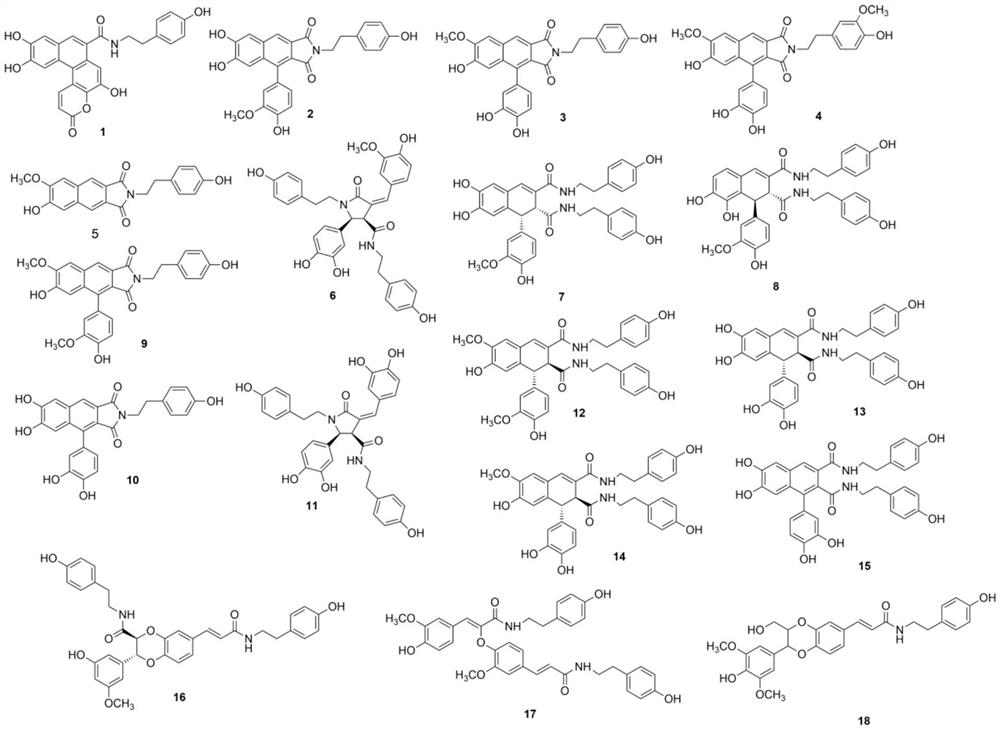Amidolignan compound in limonium latifolium root as well as preparation method and application thereof
A technology of lignans and compounds, which is applied in the field of phytochemistry, can solve the problems that have not yet been reported on the chemical constituents of eugenide lignans.
- Summary
- Abstract
- Description
- Claims
- Application Information
AI Technical Summary
Problems solved by technology
Method used
Image
Examples
Embodiment 1
[0086] a. Get 20kg of dried blood-enriching grass roots and pulverize, according to the material-to-liquid ratio of 1:3, extract 1 time with anhydrous methanol at room temperature, and the time is 5 hours, and the extract is evaporated to dryness under reduced pressure with a rotary evaporator to obtain Extract;
[0087] b. Disperse the extract obtained in step a with water, use petroleum ether, ethyl acetate and n-butanol for extraction successively, obtain the extract of each polar section after concentrating under reduced pressure at a temperature of 40 ° C in a rotary evaporator, and then concentrate to paste , obtain petroleum ether position, ethyl acetate position and n-butanol position respectively;
[0088] c. Separate 120 g of the ethyl acetate fraction obtained in step b by normal phase silica gel column chromatography, and carry out gradient elution with chloroform-methanol in a volume ratio of 100:0-1:1 to obtain 15 fractions Fr.1-Fr .15;
[0089] d. Separate the...
Embodiment 2
[0096] a. Take 20kg of dried blood-enriching grass roots and pulverize, according to the material-to-liquid ratio of 1:5, extract 3 times by cold soaking at room temperature with concentration 70% ethanol, 2 hours each time, and evaporate the extract to dryness under reduced pressure with a rotary evaporator , to obtain an extract;
[0097] b. Disperse the extract obtained in step a with water, use petroleum ether, ethyl acetate and n-butanol for extraction successively, obtain the extract of each polar section after concentrating under reduced pressure at a temperature of 40 ° C by a rotary evaporator, and then concentrate to a paste shape, respectively obtain petroleum ether site, ethyl acetate site and n-butanol site;
[0098] c. Take 130 g of the ethyl acetate fraction obtained in step b and separate it by normal phase silica gel column chromatography, and carry out gradient elution with chloroform-methanol in a volume ratio of 100:0-1:1 to obtain 15 fractions Fr.1- Fr.15...
Embodiment 3
[0106] a. Get 20kg of dried blood-enriching grass roots and pulverize, according to the material-to-liquid ratio of 1:7, ultrasonically extract once at room temperature with a concentration of 80% ethanol for 10 hours, and the extract is evaporated to dryness under reduced pressure with a rotary evaporator to obtain Extract;
[0107] b. Disperse the extract obtained in step a with water, use petroleum ether, ethyl acetate and n-butanol for extraction successively, obtain the extract of each polar section after concentrating under reduced pressure at a temperature of 40 ° C by a rotary evaporator, and then concentrate to a paste shape, respectively obtain petroleum ether site, ethyl acetate site and n-butanol site;
[0108] c. Separate the ethyl acetate fraction obtained in step b by normal phase silica gel column chromatography, and carry out gradient elution with chloroform-methanol in a volume ratio of 100:0-1:1 to obtain 15 fractions Fr.1-Fr. 15;
[0109] d. Separate Fr.2...
PUM
 Login to View More
Login to View More Abstract
Description
Claims
Application Information
 Login to View More
Login to View More - R&D
- Intellectual Property
- Life Sciences
- Materials
- Tech Scout
- Unparalleled Data Quality
- Higher Quality Content
- 60% Fewer Hallucinations
Browse by: Latest US Patents, China's latest patents, Technical Efficacy Thesaurus, Application Domain, Technology Topic, Popular Technical Reports.
© 2025 PatSnap. All rights reserved.Legal|Privacy policy|Modern Slavery Act Transparency Statement|Sitemap|About US| Contact US: help@patsnap.com



